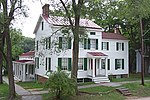Frederick Douglass Memorial Park
Frederick Douglass Memorial Park is a historic cemetery for African Americans in the Oakwood neighborhood of Staten Island, New York. It is named for abolitionist, orator, statesman, and author Frederick Douglass (1818–1895), although he is not buried there. It has burial sites for numerous prominent African Americans, including a pioneering journalist, athletes, musicians, performers, political leaders, and business people. The original 53-acre cemetery was founded in 1935 by undertaker Rodney Dade, business consultant Benjamin Diamond, and lawyer Frederick Bunn, who previously built the adjoining Valhalla Burial Park. The Frederick Douglass Memorial Park was managed by African Americans and intended to provide an attractive option for African Americans excluded from segregated cemeteries and facing high burial costs in the vicinity of New York. The first burials at the cemetery were on Monday June 10, 1935.In 1961, a bronze bas relief cenotaph monument to Frederick Douglass designed by Angus McDougall was added near the cemetery's entrance. It was reportedly the first monument in New York City honoring the civil rights leader. In May 2018, the historic red-brick pillars and wrought-iron fencing at the cemetery were removed and replaced with a "glossy placard", a move that brought a suit from the Friends of Frederick Douglass Memorial Park Inc. The cemetery had also been reduced to 17 acres by this time. The suit was thrown out by the Civil Supreme Court Justice.The memorial park opened with "perpetual care" for graves included in the burial price, but by 2018 many of the graves were in bad repair with some gravesites lost or unrecognizable.
Excerpt from the Wikipedia article Frederick Douglass Memorial Park (License: CC BY-SA 3.0, Authors).Frederick Douglass Memorial Park
Amboy Road, New York Staten Island
Geographical coordinates (GPS) Address Nearby Places Show on map
Geographical coordinates (GPS)
| Latitude | Longitude |
|---|---|
| N 40.563611111111 ° | E -74.135 ° |
Address
Amboy Road 3201
10306 New York, Staten Island
New York, United States
Open on Google Maps









